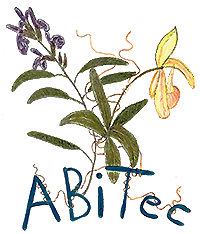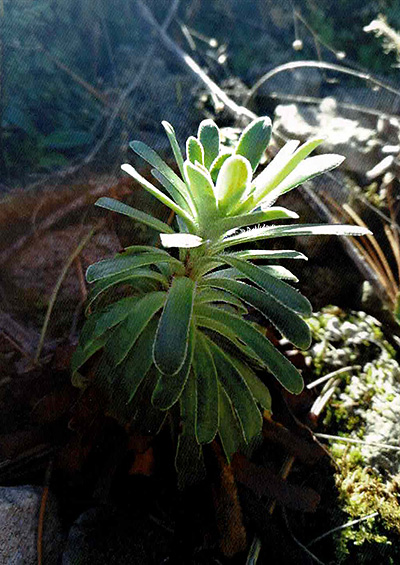20 years ago I had some sleepless nights, together with Ms Renata Burda from Sauerlach, a diploma-biologist and with the bookkeeper, Mr Ernst Schrottenloher who lived in Munich-Solln back then. We were looking for a new name for our research group, which was supposed to be dedicated to the review of our patent ideas regarding the pharmaceutical and medicinal application of the biogene substances that I had investigated. Furthermore, it should combine the establishment as well as the cataloguing of our plant collection.
20 years ago I had some sleepless nights, together with Ms Renata Burda from Sauerlach, a diploma-biologist and with the bookkeeper, Mr Ernst Schrottenloher who lived in Munich-Solln back then. We were looking for a new name for our research group, which was supposed to be dedicated to the review of our patent ideas regarding the pharmaceutical and medicinal application of the biogene substances that I had investigated. Furthermore, it should combine the establishment as well as the cataloguing of our plant collection.
Besides the testing of efficient nursing of various plant species, the collections also focus on the optimisation of the conservation breedings. In the future, we wanto to be able to contact investors via the research group to be named. The majority of the fundamental research can be attributed to the field of biotechnology, which is why we wanted to integrate this into the name somehow. After some days, I came up with ABiTec, which stands for Applied BioTechnology. Both of the co-founders liked this play with the letters, so the ABiTec-Research Group was brougt to life at the end of 1998 / beginning of 1999.
In the last 20 years, a multitude of biogene substances and their possible medicinal and pharmaceutical applications were examined by us. First patents were submitted and partially already granted. At the moment we are trying to market these first ones. Furthermore, we have structured our plant collections and strongly developed at least a part of it, depending on species and family. Additionally in 2013/2014, we started to write publications about our plants. In this context it remains important to put our results up for discussion. A few observations were published in the magazine “OrchideenZauber” (OrchidCharm) by me and Ms Elizabeth Sand or together with the geologist of our research group, Mr Philip May.
For other plants we established our own journals, for example the ‘Xanthorrhoeaceae’ (for Aloe and Grass Tree Plants as well as their relatives) and the ‘Anacampserotaceae’ (for close relatives of cactii). Meanwhile, we are working more intensively on composing a somewhat different botanical garden. Many of our plants are situated in pots or other plant containers and we want to present them in those vessels. We are revealing parts of our collection on a regular basis and until now I only received positive comments. We want to make those parts accessible to a broader public audience. Naturally, there still lies a lot of work ahead of us, but we already covered far more than half the distance. By revealing this scientific collection, we will be able to offer a portion of the plants we have bred to interested parties for sale or for exchange. Even though I find all plants “ingenious”, our special collections arouse the largest interest among many plant enthusiasts, no matter if it is their profession or a hobby. We have a large collection of nightshade plants (Solanaceae), wild forms of Sempervivum and Sedum, umbellifers (Apiaceae), nettle plants (Urticaceae), root orchids (Chiloschista u. a.), aloe plants and many more.
Besides the plants we are also very interested in their natural habitats. In my life I was able to visit many extreme habitats, such as deserts, salt lakes, alpine areas, bogs, mangrove swamps and others. Unfortunately, many of these biotopes are endangered nowadays and the species that live in them are threatened by extinction, partly even already missing. Together with Ms Renata Burda, Ms Elisabeth Sand and the geologist Philip May, we observe the developments of the Kirchsee-bog since 25 years. Since more than 10 years, we are observing the developments of specific sections on the upper isar, which is also captured through photographs. One or two publications about that have also already been drafted. However, a few years ago we started focusing on finding plant species that could be recognised as flagship-bioindicators. Based on my observations and after consultations of the members of the research group as well as with visitors of the respective habitats, we propose following species: Pinguicula alpina (alpine butterwort) for the Kirchsee and Saxifraga mutata (gravel saxifrage) for the Isar. The observations about the populations of these two plant species are only one of the lasting research contributions that are provided by ABiTec.


Root orchids of the genus Chiloschista - left: Chiloschista cf. lunifera; right: Chiloschista parishii.
Besides the observations in nature, we also have ex situ-conservations breedings for different species. We received the original plants from botanical gardens, museums, plant collectors or from seed collections. Another portion that should not be overlooked was given to us from specialised nurseries. We are testing a variety of substrates and climatic conditions in order to obtain strong and long-lasting plants. Naturally, our long-term objective also includes the resettlement in nature as well as the strengthening of natural populations.
It has been known for a long time that plants have healing and toxic attributes. However, regarding their specific effects and consitutents only a fraction of the 390 000 known plant species have been researched. In the last 35 years, I found different plant genus and species with constitutens that have high potential for the treatment of many diseases. We as ABiTec want to further process these findings together with investors, so that, in the future, our knowledge can be offered by pharmaceutical companies to the diseased people. Through this we also want to point out the importance of plants for the earth and for us people. Plants can still offer many new things in pharmacy and medicine as well as for technology and nutrition. ABiTec will also make a contribute to this.
Besides the two already mentioned focal points for our research, nature conservation and preservation of species and looking for substances for pharmacy and medicine, we also have a third one that refers to the evolution of plants. We nurse some species such as Welwitschia mirabilis, Wollemia nobilis, Gingko biloba and more, which are described as living fossils. Furthermore we are investigating relic types that remained after the ice ages, for example the Felsenteller Ramonda, Haberlea und Jancaea.
Additionally to the living plants, we are involved in setting up a fossil collection that can be used for the purpose of comparison, as well as building a geological substrate collection, that can give an indication about former and current soil properties, in which the respective species has found its niche for survivals.
,
Rauenzell, September 2018


